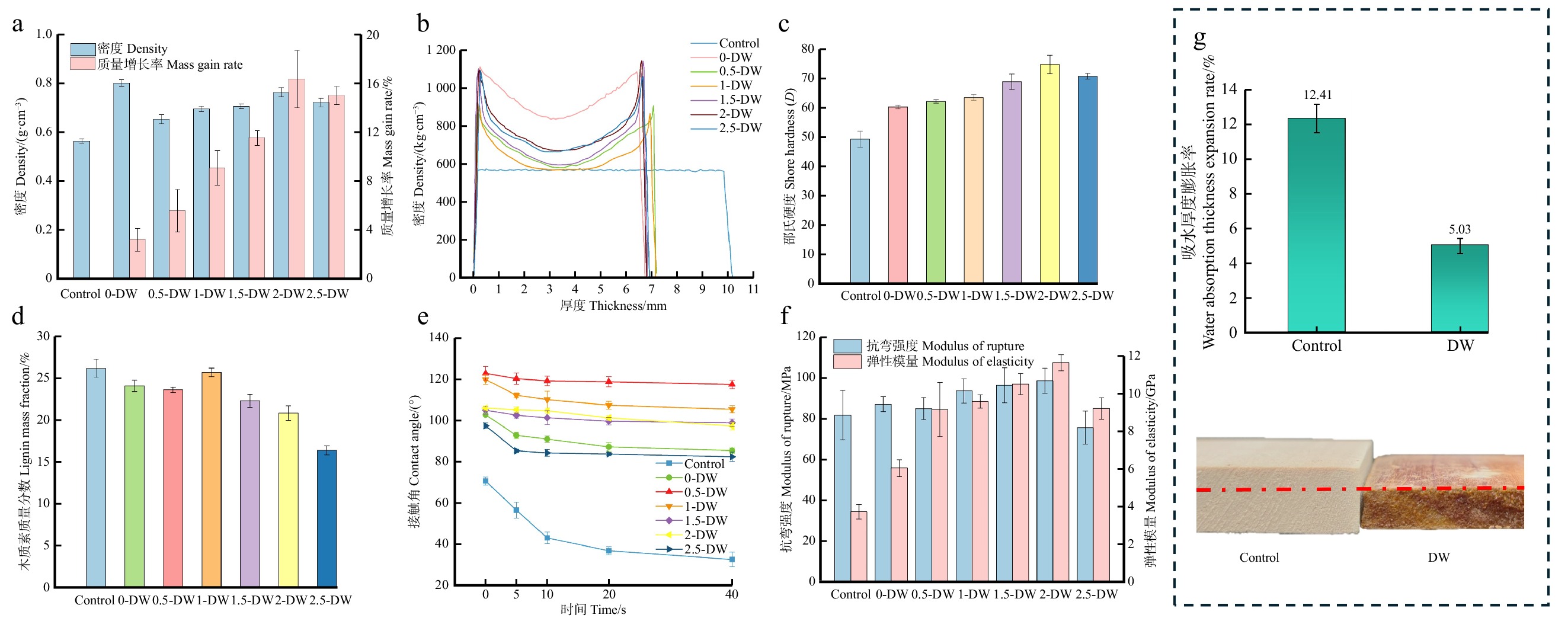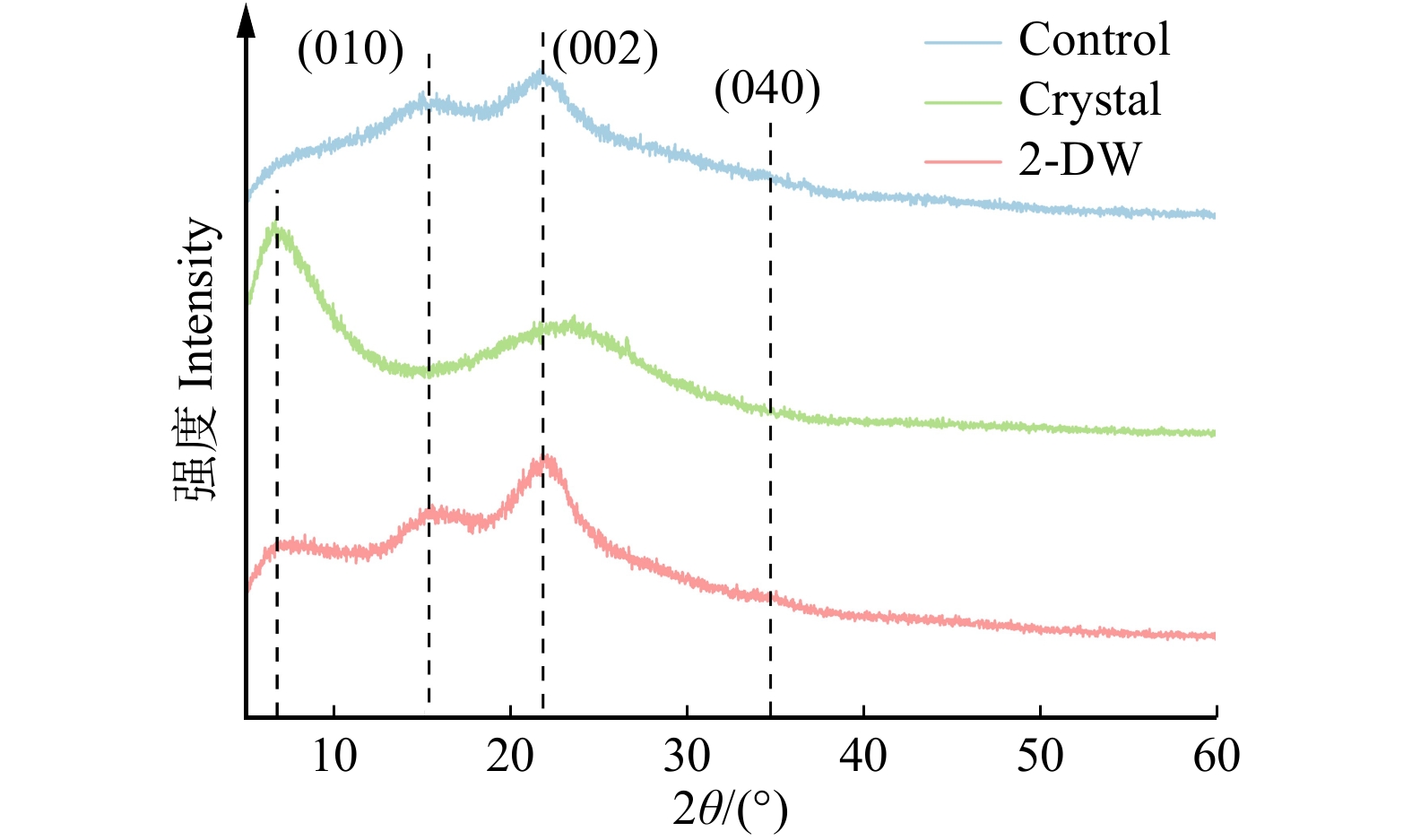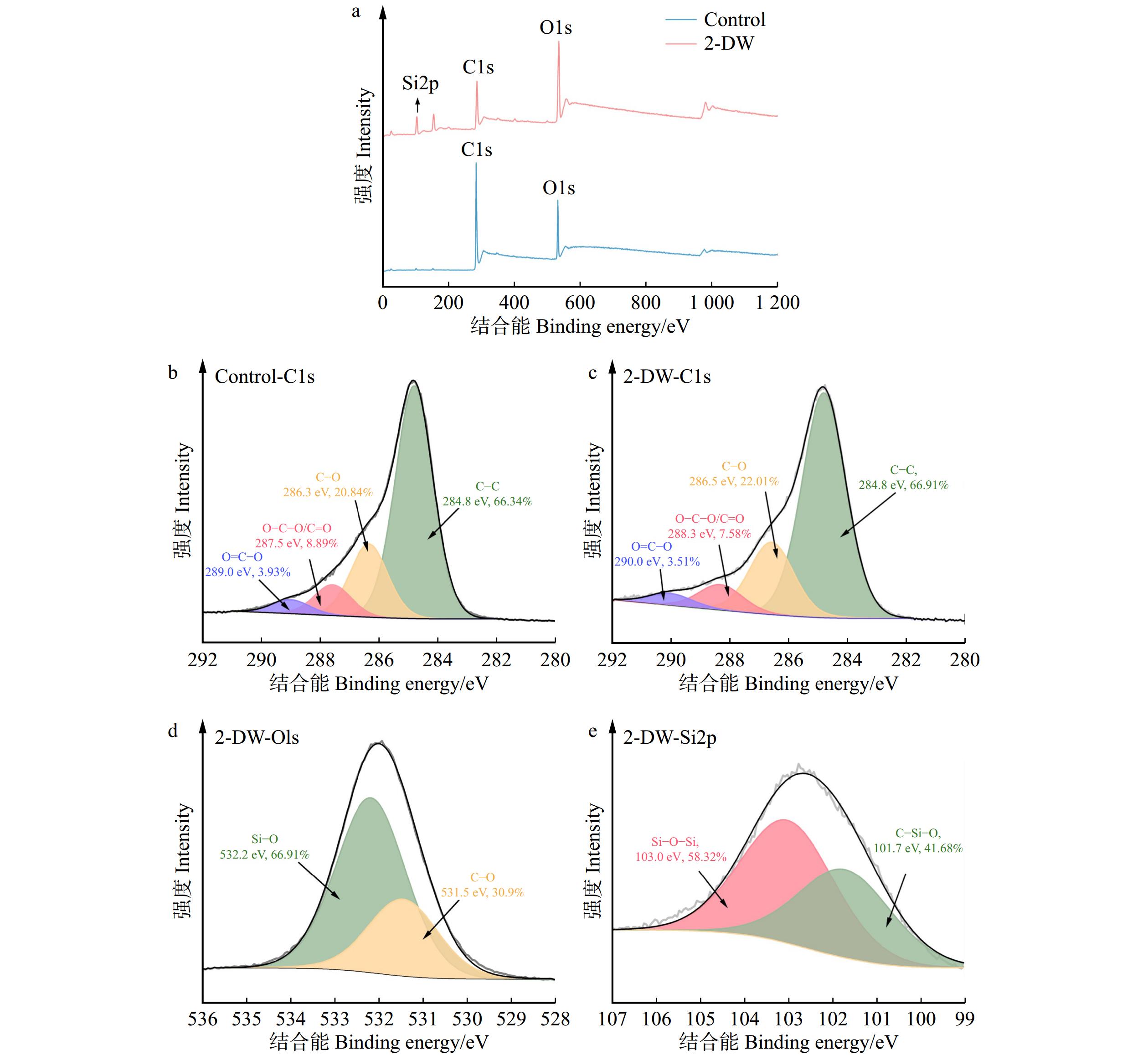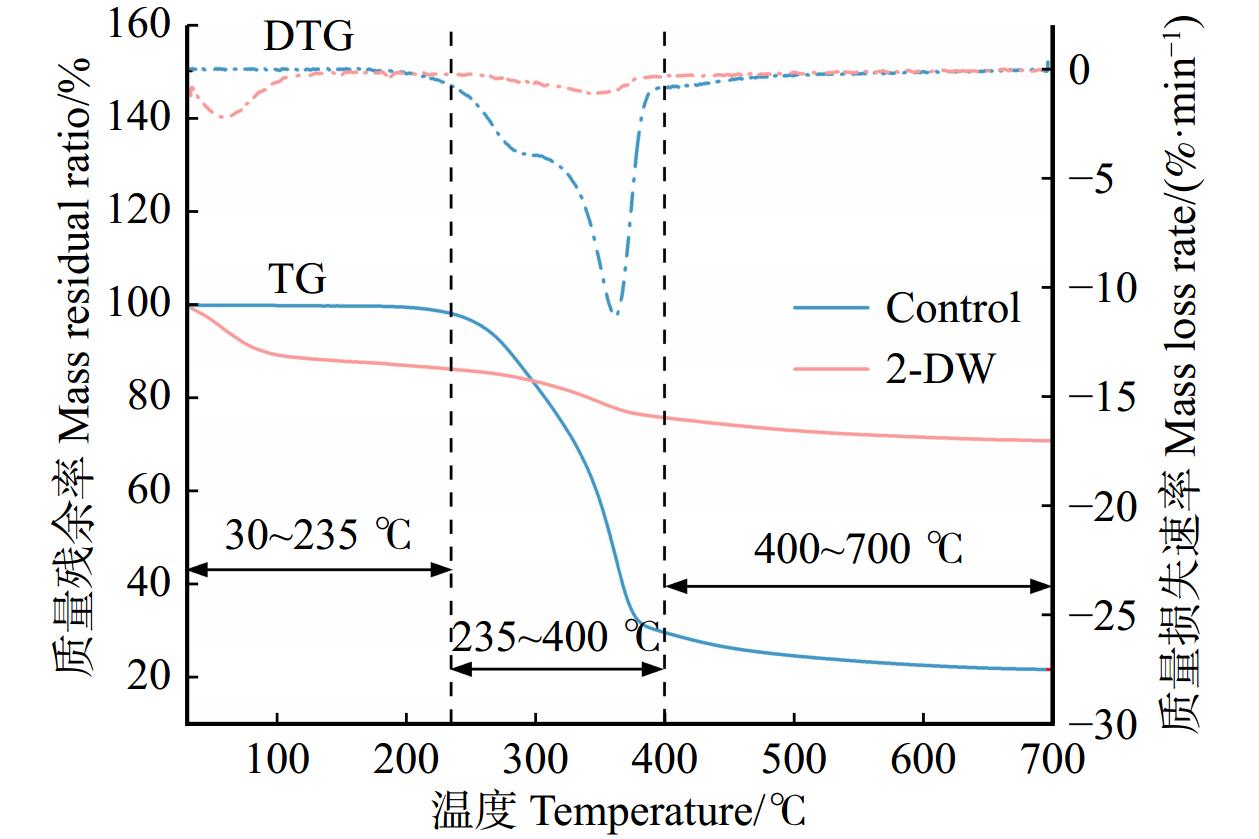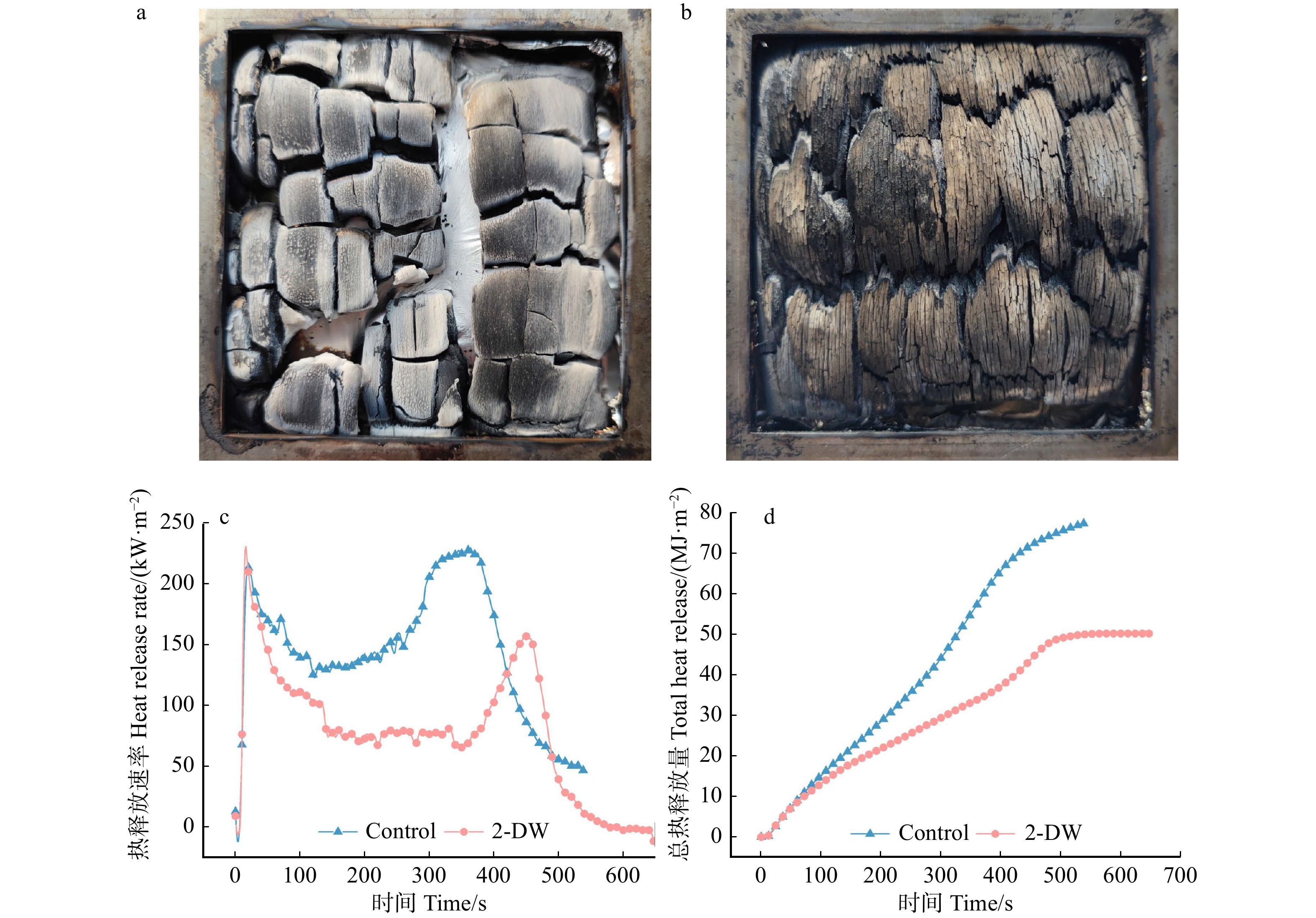Effects of deep eutectic solvents pretreatment on performance of surface mineralized wood
-
摘要:目的
为了解决木材矿化改性渗透难、矿化位点少等问题,本研究采用低共熔溶剂(DES)预处理速生杨木、打开木材渗透通道、构建活性位点,研究低共熔溶剂预处理对表面矿化木材性能的影响。
方法本研究使用DES预处理杨木构建矿化位点,诱导SiO2在木材表面实现原位矿化,再通过热压制备表面矿化木材,分析DES预处理对表面矿化木材物理力学性能的影响作用;以较优条件制备表面矿化木材,并分析其微观结构形貌和热性能。
结果(1)表面矿化木材的密度、质量增长率和表面硬度均随DES预处理时间的增加呈先上升后下降的趋势;预处理为2 h时,较未处理材分别提高了35.25%、16.35%和51.53%;表面矿化木材的疏水性大幅提高,预处理0.5 h时初始接触角增大了74.08%。(2)DES预处理可以显著改善表面矿化木材力学性能;当DES预处理时间为2 h时,表面矿化木材的抗弯强度和弹性模量分别提升了20.53%和214.55%。(3)表面矿化处理向木材内引入SiO2形成有机–无机杂化结构,提高木材阻燃性能;DES预处理2 h时,表面矿化木材的质量残余率相较于未处理材提高了70.81%,热释放速率降低了69.9 kW/m2,总热释放量降低了27.3 MJ/m2。
结论速生杨木经DES预处理和表面矿化联合改性后物理力学性能提升,热稳定性和阻燃性能良好。
Abstract:ObjectiveIn order to solve the problems of difficult penetration and less mineralization sites in wood mineralization modification, deep eutectic solvent (DES) pretreatment was used to open the penetration channel and construct active sites of fast-growing poplar, and the effects of DES pretreatment on the properties of surface mineralized wood were studied.
MethodPoplar wood was pretreated with DES to construct mineralization sites, and SiO2 was induced to realize in-situ mineralization on the wood surface. Then surface mineralized wood was prepared by hot pressing. The effects of DES pretreatment on physical and mechanical properties of surface mineralized wood were analyzed. Surface-mineralized wood was prepared under optimal conditions, and its microstructure morphology and thermal properties were analyzed.
Result(1) The density, mass gain rate and surface hardness of surface mineralized wood increased at first and then decreased with the increase of DES pretreatment time, and increased by 35.25%, 16.35% and 51.53%, respectively when pretreated for 2 h compared with untreated wood. The hydrophobicity of surface mineralized wood was greatly improved, and the initial contact angle increased by 74.08% after 0.5 h pretreatment. (2) DES pretreatment can significantly improve the mechanical properties of surface mineralized wood. When DES pretreatment time was 2 h, the modulus of rupture and elasticity of surface mineralized wood increased by 20.53% and 214.55%, respectively. (3) The surface mineralization treatment introduced SiO2 into the wood to form an organic-inorganic hybrid structure, which improved the fire resistance of wood. When the surface mineralized wood was pretreated for 2 h, the mass residual ratio of the surface mineralized wood increased by 70.81% compared with the untreated wood, and the heat release rate reduced by 69.9 kW/m2, and the total heat release reduced by 27.3 MJ/m2.
ConclusionAfter DES pretreatment and surface mineralization, the physical and mechanical properties of fast-growing poplar are improved, and the thermal stability and fire resistant properties are good.
-
土壤有机碳(soil organic carbon,SOC)是植物和微生物生长所必需的物质能量来源,是影响土壤肥力、生产力和养分有效性的关键因素,对土壤理化特性具有重要调节作用[1]。SOC储量分布特征是其长期累积的结果,与土壤剖面的发育密切相关。人工林生态系统具有较强的碳汇和增汇潜能[2],被认为是实现“双碳”目标最经济、最安全的有效途径之一[3]。人工林大面积营建改良了土壤质量,改变了土壤有机质的输入与分解方式,利于SOC贮存和积累[4],人工林土壤碳库库容较大,能维持较稳定的碳储量[5−6]。然而,人工林SOC的贮存受土壤理化性质、植被类型和地形等诸多因素的影响[7−8],关于不同人工林下SOC分布特征尚未达成共识。大量研究基于土壤表层或单一林分,吴慧等[9]研究得出热带山地雨林次生林在0 ~ 50 cm垂直方向上土壤有机碳质量分数随土壤深度增加而减小;王越等[10]通过文献整合分析得出油松(Pinus tabuliformis)林0 ~ 20 cm有机碳储量最高,20 ~ 60 cm稳定且保持较低水平;张智勇等[11]认为陕北黄土区沙棘林有机碳储量优于草地和油松林。据《全球森林评估》报道,我国人工林面积居世界前列[12],人工林生态系统对森林生态系统碳储量增加的贡献较大[13],因此阐明不同人工林SOC储量的分布特征在宏观方向上研究森林碳汇尤为重要。
黄土高原生境脆弱,水土流失严重。随着“退耕还林还草”生态工程的实施,黄土高原植被覆盖大幅增加[14],不同人工林土壤固碳问题逐渐成为研究者们关注的热点问题[15]。土地利用变化的改变增强了土壤碳汇功能[16]。Zhang等[17]研究得出退耕后土壤有机碳储量在0 ~ 20 cm以36.67 g/(m2· a)的速率发生巨大的变化,包玉斌[18]研究了2000—2010年陕北黄土高原退耕年间,其退耕地土壤碳固存总量增加。目前,关于黄土高原SOC储量的研究多集中在大尺度空间分布[19]、单一人工林[20]、模型拟合[21]和浅层土壤(0 ~ 100 cm)[11]。这些研究仅是土地利用前后或退耕后单一林地与草地或农田之间的对比研究,而对于退耕后不同人工林及深层土壤SOC储量的研究较少。相关研究表明,土壤是一个不均匀且不连续的时空变异体[22],其演化过程十分复杂。土壤碳库的分布特征,因缺乏连续、可靠、统一的土壤剖面资料,区域SOC储量实测及代表性数据贫乏[23],存在明显的不确定性[24]。因此,准确评估退耕后小尺度不同人工林SOC储量的分布特征,对森林土壤有机碳库的精确估算以及土壤碳汇研究具有重要意义。
鉴于此,本研究以黄土丘陵区典型同一退耕年限的人工油松林、山杏(Armeniaca sibirica)林、沙棘(Hippophae rhamnoides)林和天然草地0 ~ 200 cm土壤为研究对象,探究不同人工林SOC储量的垂直分布特征,以期为准确计算黄土高原有机碳储量提供数据支撑,为建立黄土高原土壤碳库,优化人工林土壤固碳格局提供理论依据。
1. 研究区概况与研究方法
1.1 研究区概况
研究区位于陕西省吴起县(107°38′57″ ~ 108°32′49″ E,36°33′33″ ~ 37°24′27″ N),海拔高度1 233 ~ 1 809 m,是典型的黄土高原丘陵沟壑区。吴起县地处中温带半湿润—半干旱区域,温带大陆性季风气候特征明显,年均温7.8 ℃,年平均降水量483.4 mm,时空分布不均,主要集中在7—9月,年无霜期146 d。主要土壤类型为黄绵土,结构疏松、持水力低、易侵蚀。自1999年坡耕地转变为林地以来,形成了刺槐(Robinia pseudoacacia)、油松、侧柏(Platycladus orientalis)、山杏、沙棘、柠条(Caragana sinica)、白莲蒿(Artemisia stechmanniana)、达乌里胡枝子(Lespedeza daurica)等以及自然恢复草地为主的乔灌草植物群落,全县林草覆盖率显著增加,生态环境得以改善。
1.2 土壤样品采集与处理
于2020年9月进行样品采集,在研究区选择相同退耕年限的典型人工油松林、山杏林、沙棘林和天然草地,分别布设25 m × 25 m大样方,利用GPS采集地理信息数据,样地基本信息如表1。使用内径6 cm的土钻,在样方内,采用五点采样法,以0 ~ 20 cm、20 ~ 40 cm、40 ~ 60 cm、60 ~ 100 cm、100 ~ 150 cm、150 ~ 200 cm分层采集土壤样品,带回实验室进行分析。待土壤样品风干后,研磨、过筛,进行理化性质测定。土壤密度采用环刀法测定,土壤有机碳采用重铬酸钾稀释热法测定,全氮采用半微量凯式定氮法测定,全磷采用硫酸−高氯酸消煮−钼锑抗比色法定,全碳通过元素分析仪测定,无机碳根据全碳、有机碳之间关系获得,碱解氮采用碱解扩散法测定,速效磷采用钼锑抗比色法测定,土壤粒度组成使用激光粒度分析仪(Mastersize-zer 3000)测定[25]。
表 1 样地基本信息Table 1. Basic information of the sample plots人工林
Plantation海拔
Elevation/m坡度
Gradient/(°)坡向
Aspect平均高度
Average
height/m平均胸径
Average DBH/cm郁闭度或盖度
Crown density or
coverage林下优势种
Dominant understory
species油松 Pinus tabuliformis 1 362.6 20 SFS 8.5 11.3 0.65 MO, LB, ASB 山杏 Armeniaca sibirica 1 459.7 21 SFS 7.3 10.4 0.62 ASB, PS, LB, PC 沙棘 Hippophae rhamnoides 1 389.9 6 NFS 2.9 3.5 0.71 LS, ASW, LB 草地 Grassland 1 376.7 33 SFS 0.86 LB, LS, SC 注:SFS. 阳坡;NFS. 阴坡;MO. 草木犀;LB. 胡枝子;ASB. 白莲蒿;PS. 败酱;PC. 委陵菜;LS. 赖草;ASW. 猪毛蒿;SC. 针茅。Notes: SFS, south-facing slope; NFS, north-facing slope; MO, Melilotus officinalis; LB, Lespedeza bicolor; ASB, Artemisia stechmanniana; PS, Patrinia scabiosaefolia; PC, Potentilla chinensis; LS, Leymus secalinus; ASW, Artemisia scoparia; SC, Stipa capillata. 土壤有机碳储量计算公式为
SOC储量=wSOCi×ρBDi×Di×0.01 式中:SOC储量表示土壤有机碳储量(g/m2),wSOCi表示第i层的土壤有机碳含量(g/kg),ρBDi表示第i层的土壤密度(g/cm3),Di表示第i层的土层厚度。
1.3 数据处理
应用SPSS26.0对数据进行统计分析,采用单因素方差分析(ANOVA)对比不同人工林、不同土层深度有机碳储量之间的差异;应用Origin2018对土壤有机碳储量与土壤理化性质、不同人工林、地形等影响因素之间的关系强弱和作用机理进行PCA分析并绘图;应用R4.2.1对土壤有机碳储量和各环境变量的贡献关系进行冗余分析。
2. 结果与分析
2.1 有机碳储量分布特征
研究区0 ~ 200 cm土层平均SOC储量由大到小为山杏(16.190 g/m2) > 草地(15.403 g/m2) > 沙棘(11.449 g/m2) > 油松(10.188 g/m2)(表2)。不同人工林SOC储量变异系数在10% ~ 30%,为中等程度变异,表现为沙棘(0.219) > 山杏(0.136) > 油松(0.124) > 草地(0.115)。变异系数表征了SOC储量的空间异质性,沙棘的SOC储量空间异质性最大,草地的SOC储量空间异质性最低。
表 2 不同人工林土壤有机碳储量描述统计Table 2. Description statistical characteristics of soil organic carbon stocks content in different plantations人工林
Plantation土层 Soil
layer/cm平均值
Mean value/(g·m−2)最大值
Max. value/(g·m−2)最小值
Min. value/(g·m−2)标准差
Standard deviation变异系数
Variation coefficient占比
Proportion油松
Pinus tabuliformis0 ~ 20 11.658 12.197 10.627 0.893 0.077 0.191 20 ~ 40 7.009 9.253 4.457 2.412 0.344 0.115 40 ~ 60 7.691 8.506 7.267 0.706 0.092 0.126 60 ~ 100 10.246 12.052 8.016 2.051 0.200 0.167 100 ~ 150 13.491 13.844 13.040 0.411 0.030 0.221 150 ~ 200 11.035 11.050 11.010 0.022 0.002 0.180 0 ~ 200 10.188 13.490 7.008 1.082 0.124 山杏
Armeniaca sibirica0 ~ 20 19.049 20.198 16.988 1.789 0.094 0.196 20 ~ 40 13.201 17.450 10.940 3.683 0.279 0.136 40 ~ 60 11.359 12.901 10.199 1.390 0.122 0.117 60 ~ 100 19.106 23.617 15.815 4.041 0.211 0.197 100 ~ 150 20.097 22.132 19.009 1.764 0.088 0.207 150 ~ 200 14.332 14.670 14.033 0.320 0.022 0.147 0 ~ 200 16.190 20.097 11.359 2.184 0.136 沙棘
Hippophae rhamnoides0 ~ 20 19.692 24.417 16.385 4.199 0.214 0.287 20 ~ 40 9.659 13.084 7.616 2.984 0.309 0.141 40 ~ 60 5.912 8.583 4.269 2.333 0.395 0.086 60 ~ 100 8.850 10.196 7.530 1.333 0.151 0.128 100 ~ 150 13.247 15.749 11.861 2.171 0.164 0.193 150 ~ 200 11.333 12.417 10.544 0.971 0.086 0.165 0 ~ 200 11.449 19.691 5.912 2.331 0.219 草地 Grassland 0 ~ 20 19.906 22.351 16.274 3.208 0.161 0.215 20 ~ 40 10.066 11.177 8.118 1.692 0.168 0.109 40 ~ 60 9.256 10.564 8.160 1.216 0.131 0.100 60 ~ 100 14.409 15.494 12.767 1.446 0.100 0.156 100 ~ 150 20.021 20.836 18.609 1.228 0.061 0.217 150 ~ 200 18.760 20.178 17.629 1.299 0.069 0.203 0 ~ 200 15.403 20.021 9.255 1.681 0.115 在不同人工林中(图1),在0~200 cm剖面上SOC储量呈现出山杏(97.145 g/m2) > 草地(92.418 g/m2) > 沙棘(68.695 g/m2) > 油松(61.130 g/m2)的分布格局,山杏的SOC储量与油松、沙棘差异显著(P < 0.05)。人工油松林,山杏林,沙棘林与天然草地0 ~ 60 cm SOC储量占整个剖面的43.11%、44.89%、51.33%、42.45%,表层碳储量高。垂直分布上,油松、山杏、沙棘的SOC储量自表层向下随深度增加变异系数先增大后减小,在20 ~ 40 cm土层变异系数达到最大,草地的SOC储量自表层向下随深度增加变异系数减小。在不同深度土层中,油松的SOC储量与山杏、沙棘、草地在0 ~ 20 cm、20 ~ 40 cm、150 ~ 200 cm土层差异显著(P < 0.05),沙棘的SOC储量与山杏、油松、草地在40 ~ 60 cm、60 ~ 100 cm土层差异显著(P < 0.05),油松、沙棘的SOC储量与山杏、草地在100 ~ 150 cm土层差异显著(P < 0.05)。
2.2 环境因素对典型人工林土壤有机碳储量的影响
典型人工林SOC储量空间变异的主成分分析如下(图2),第一轴和第二轴解释值分别为39.70%和22.70%。第一主成分与部分环境指标的相关系数在0.37以上,其中,PC1与粉粒、黏粒、坡度正相关,与砂粒负相关,第一主成分主要包含了土壤物理性质信息;第二主成分与部分环境指标的相关系数0.5以上,其中PC2与全碳、碱解氮、全氮正相关,主要包含了土壤化学信息,第一和第二主成分反映的信息量占总信息量的62.40%。
![]() 图 2 土壤有机碳储量与土壤环境因子的主成分分析TP. 全磷;TN. 全氮;TC. 全碳;SIC. 土壤无机碳;AP. 速效磷;AN. 碱解氮;Clay. 黏粒;Silt. 粉粒;Sand. 砂粒;ELE. 海拔;SA. 坡向;SG. 坡度。下同。PC1. 第一主成分;PC2. 第二主成分。TP, total phosphorus; TN, total nitrogen; TC, total carbon; SIC, soil inorganic carbon; AP, available phosphorus; AN, alkali-hydrolyzable nitrogen; Clay, clay; Silt, silt; Sand, sand; ELE, elevation; SA, slope aspect; SG, slope gradient. The same below. PC1, the first principal component; PC2, the second principal component.Figure 2. Principal component analysis of soil organic carbon stocks and soil environmental factors
图 2 土壤有机碳储量与土壤环境因子的主成分分析TP. 全磷;TN. 全氮;TC. 全碳;SIC. 土壤无机碳;AP. 速效磷;AN. 碱解氮;Clay. 黏粒;Silt. 粉粒;Sand. 砂粒;ELE. 海拔;SA. 坡向;SG. 坡度。下同。PC1. 第一主成分;PC2. 第二主成分。TP, total phosphorus; TN, total nitrogen; TC, total carbon; SIC, soil inorganic carbon; AP, available phosphorus; AN, alkali-hydrolyzable nitrogen; Clay, clay; Silt, silt; Sand, sand; ELE, elevation; SA, slope aspect; SG, slope gradient. The same below. PC1, the first principal component; PC2, the second principal component.Figure 2. Principal component analysis of soil organic carbon stocks and soil environmental factors2.3 环境因素对土壤剖面有机碳储量垂直分布的影响
不同环境因素对SOC储量垂直变化的贡献度不同(图3)。土壤化学性质、土壤物理性质、地形和植被群落分别对0 ~ 200 cm土壤剖面中SOC储量分布差异的影响约占51.84%、13.58%、30.71%和3.87%。在土壤化学性质中,0 ~ 200 cm SOC储量的变化受全磷影响最大(11.99%),受全氮影响最小(5.64%);在土壤物理性质中,0 ~ 200 cm SOC储量的变化受砂粒影响最大(5.65%),受黏粒影响最小(2.89%);在地形因素中,0 ~ 200 cm SOC储量的变化受海拔影响最大(19.66%),受坡向影响最小(4.97%);植物群落对0 ~ 200 cm SOC储量变化影响较小。
![]() 图 3 土壤化学性质、土壤物理性质、地形和植物群落对土壤有机碳储量变化的相对贡献SCP. 土壤化学性质;SPP. 土壤物理性质;Topo. 地形;PT. 植物群落。SCP, soil chemical property, SPP, soil physical property, Topo, topography, PT, phytocoenosium.Figure 3. Relative contribution of soil chemistry, soil physical properties, topography and phytocoenosium to changes in soil organic carbon stocks
图 3 土壤化学性质、土壤物理性质、地形和植物群落对土壤有机碳储量变化的相对贡献SCP. 土壤化学性质;SPP. 土壤物理性质;Topo. 地形;PT. 植物群落。SCP, soil chemical property, SPP, soil physical property, Topo, topography, PT, phytocoenosium.Figure 3. Relative contribution of soil chemistry, soil physical properties, topography and phytocoenosium to changes in soil organic carbon stocks3. 讨 论
3.1 不同人工林土壤有机碳储量分布差异的对比
本研究发现SOC储量富集在土壤表层,呈现出明显的“表聚性”,这与王文静等[26]的研究结论一致。不同植被群落在土壤浅层聚集了大量的根系和凋落物,凋落物分解产生有机质归还于土壤,通过养分的循环进入土壤[27],因此,大量的有机碳在土壤表层形成和累积。
本研究中,山杏林表现出最优的土壤固碳效益,草地次之,油松林最差,这与李龙波等[28]对乔灌草固碳效益效果的研究结果不一致。植被类型和植被生长间的差异会导致土壤温度、湿度、凋落物数量和根系分泌物等的显著不同[29],进而影响土壤的固碳效益。本研究中草地植被覆盖度高于油松和沙棘林下植被覆盖度(表1),单位面积的植被残体、根系分泌物、枯枝落叶量多,有机质输入量更高,同时,适宜的土壤温度和湿度促进了微生物的生长代谢,提高了植被残体的分解速率,使得草地土壤固碳效率提高。不同人工林中,植物生产力和质量的巨大差异导致SOC储量空间分布的显著差异[30]。且有研究表明,在年平均降水量 < 510 mm区域,草地比灌木和林地积累更多的有机碳[31],本研究区位于黄土丘陵区,年降水量483.4 mm,草地SOC储量高于沙棘和油松。落叶乔木在增加枯落物归还量方面明显优于常绿乔木,这在诸多研究中均有报道[32]。本研究中山杏SOC储量远高于油松,是因为落叶阔叶乔木比常绿针叶乔木产生更多的枯落物凋落量[32],山杏林表层枯落物多,根密度大,不断更替的根系结合不断积累的地表枯落物,不仅改变了土壤腐殖质,也改善了土壤质地,增加了土壤有机碳的积累,因此山杏林具有较高的土壤碳储量,碳汇功能表现较强。
3.2 土壤有机碳储量空间差异的主要影响因素和作用机制
本研究中,不同人工林土壤有机碳储量与黏粒、粉粒和坡度正相关,砂粒与土壤有机碳储量负相关,这阐释了土壤粒径及坡度与土壤有机碳储量之间的关系,这与李顺姬等[33]的研究结果一致。土壤结构是影响有机质分解的主导因素[34],黏粒对土壤有机碳有很好的保护作用,砂质土壤有机碳的矿化更为迅速[33]。当土壤黏粒含量较高时,具有较大的表面积,易形成较多的毛细管,有较强的毛管作用,完整的土壤孔隙为有机碳自表层向下层传输提供了通道,促进深层土壤有机碳固存[35],具有较强的固碳能力。而当土壤砂粒含量较高时,有效土层薄,土壤生物作用弱,土壤有机碳矿化作用较弱,微生物群落质量较低,土壤固碳能力较低。黄土丘陵区“退耕还林还草”工程对土壤机械组成产生一定的影响,使土壤物理性质发生变化。土壤机械组成影响土壤孔隙度、密度,改变土壤的透气性和持水能力,改变植物根系的生长发育及微生物活动条件,进而影响有机碳的储存[36]。坡度显著影响土壤有机碳固存,坡度通过影响水分运移、植被分布及土壤机械组成等间接影响土壤有机碳储量。
本研究中,土壤化学性质对SOC储量的影响较大,全氮、碱解氮、全磷对土壤有机碳储量正向效应显著,阐释了土壤有机碳与土壤养分之间的关系。土壤全氮和碱解氮对土壤有机碳的转化和固存有重要作用。全氮对有机碳储量起正向效应,较高的全氮可以降低凋落物中的碳氮比,避免微生物与植物的“争氮”现象,利于凋落物矿化分解[37],促进土壤有机碳储存。这与王越等[10]研究得出全氮对土壤有机碳呈显著正效应的结果一致。有研究表明,地形显著影响土壤发育、迁移等活动,从而影响土壤碳的输入输出过程[38]。黄土丘陵区水土流失导致了流域内水土资源的重新分配,冗余分析表明,海拔对土壤剖面有机碳储量贮存起主要贡献(图3),通过调控水热条件,进而影响土壤有机碳的积累[39]。
4. 结 论
(1)研究区不同人工林土壤碳储量不同,表现为山杏 > 草地 > 沙棘 > 油松。因此,在黄土高原地区进行人工林营建时,可优先配置山杏林与适宜草种,以增加黄土高原土壤固碳。
(2)研究区不同人工林土壤有机碳储量与土壤机械组成和土壤养分显著相关,黏粒、粉粒、砂粒、全氮、碱解氮是影响黄土丘陵区不同人工林土壤有机碳储量空间分布的主导因子。
(3)研究区人工林土壤有机碳储量在土壤剖面中差异较大,土壤有机碳储量的垂直分布主要受地形的影响。其中,海拔通过影响有机碳的转化与固存对土壤有机碳储量的贮存起主要贡献作用。
-
图 2 未处理材(control)与表面矿化木材(DW)物理力学性能
a. 密度与质量增长率Density and mass gain rate;b. 剖面密度分布Profile density distribution;c. 邵氏硬度Shore hardness;d. 木质素质量分数Lignin mass fraction;e. 表面接触角Surface contact angle;f. 抗弯强度与弹性模量Flexural strength and modulus of elasticity;g. 吸水厚度膨胀率Water absorption thickness expansion rate
Figure 2. Physical and mechanical properties of untreated wood (control) and surface mineralized wood (DW)
图 5 未处理材(control)与表面矿化木材(2-DW)的光电子能图谱
a. 未处理材与表面矿化木材的全谱Full spectra of untreated wood and surface mineralized wood;b. 未处理材C1s区的精细谱Fine spectrum of C1s region of untreated wood;c.表面矿化木材C1s区的精细谱Fine spectrum of C1s region of surface mineralized wood;d. 表面矿化木材O1s区的精细谱Fine spectrum of O1s region of surface mineralized wood;e. 表面矿化木材Si2p区的精细谱Fine spectrum of Si2p region of surface mineralized wood
Figure 5. Photoelectric sub-spectra of untreated wood (control) and surface mineralized wood (2-DW)
图 6 未处理材、DES预处理材和表面矿化木材的SEM图
a.未处理材Untreated wood;b. DES预处理材DES pretreated wood;c. 表面矿化木材Surface mineralized wood;d. 表面矿化木材横切面Si的SEM-EDS线扫图SEM-EDS line scan map of Si on the cross section of surface mineralized wood;CML. 复合胞间层 Compound middle lamella
Figure 6. SEM images of untreated wood, DES pretreated wood and surface mineralized wood
图 8 锥形量热数据分析图
a.未处理材(control)燃烧后形貌Morphology of untreated wood (control) after combustion;b. 表面矿化木材(2-DW)燃烧后形貌Morphology of surface mineralized wood (2-DW) after combustion;c. 未处理材和表面矿化木材的HRR图HRR maps of untreated wood and surface mineralized wood;d. 未处理材和表面矿化木材的THR图THR maps of untreated and surface mineralized wood
Figure 8. Conical calorimetric data analysis diagram
-
[1] Yang T, Xia M, Chen S, et al. Enhancing the thermal stability of silica-mineralized wood via layer-by-layer self-assembly[J]. Journal of Thermal Analysis and Calorimetry, 2021, 145(2): 309−318. doi: 10.1007/s10973-020-09786-6
[2] 陈世尧, 袁光明, 杨涛, 等. 壳聚糖-SiO2仿生物矿化协同改性尾巨桉木材[J]. 材料导报, 2020, 34(10): 10182−10186. doi: 10.11896/cldb.19070157 Chen S Y, Yuan G M, Yang T, et al. Synergistic modification of eucalyptus urophylla wood by chitosan-SiO2 biomimetic mineralization[J]. Materials Reports, 2020, 34(10): 10182−10186. doi: 10.11896/cldb.19070157
[3] 刘永壮. 低共熔溶剂对木质资源组分高效分离和转化利用[D]. 哈尔滨: 东北林业大学, 2019. Liu Y Z. Efficient lignocellulosic resources fractionation and valorization in deep eutectic solvents[D]. Harbin: Northeast Forestry University, 2019.
[4] 中国林业科学研究院木材工业研究所. 无疵小试样木材物理力学性质试验方法: GB/T 1927.9—2021[S]. 北京: 中国标准出版社, 2021. Research Institute of Wood Industry, Chinese Academy of Forestry. Test methods for physical and mechanical properties of small clear wood specimens: GB/T 1927.9−2021[S]. Beijing: Standards Press of China, 2021.
[5] Ran Y, Lu D, Jiang J, et al. Deep eutectic solvents-assisted wood densification: a promising strategy for shape-fixation[J]. Chemical Engineering Journal, 2023, 471: 144476. doi: 10.1016/j.cej.2023.144476
[6] Francisco M, Den B, Adriaan V, et al. New natural and renewable low transition temperature mixtures (LTTMs): screening as solvents for lignocellulosic biomass processing[J]. Green Chemistry, 2012, 14(8): 2153−2157.
[7] Yahyaee S M H, Dastoorian F, Ghorbani M, et al. Combined effect of organosolv delignification/polymerization on the set recovery of densified poplar wood[J]. European Journal of Wood and Wood Products, 2022, 80(2): 367−375. doi: 10.1007/s00107-021-01756-5
[8] Guo J, Wang C, Li C, et al. Effect of acetylation on the physical and mechanical performances of mechanical densified spruce wood[J]. Forests, 2022, 13(10): 1−10.
[9] 李航. 二氧化硅矿化杨木复合材料制备与性能研究[D]. 长沙: 中南林业科技大学, 2022. Li H. Preparation and properties of silica mineralized poplar composites[D]. Changsha: Central South University of Forestry and Technology, 2022.
[10] Xia S, Baker G A, Li H, et al. Aqueous ionic liquids and deep eutectic solvents for cellulosic biomass pretreatment and saccharification[J]. Rsc Advances, 2014, 4(21): 10586−10596. doi: 10.1039/c3ra46149a
[11] Alvarez-Vasco C, Ma R, Quintero M. Unique low-molecular-weight lignin with high purity extracted from wood by deep eutectic solvents (DES): a source of lignin for valorization[J]. Green Chemistry, 2016, 18(19): 5133−5141. doi: 10.1039/C6GC01007E
[12] Zhu Y, Yu Z, Zhu J, et al. Developing flame-retardant lignocellulosic nanofibrils through reactive deep eutectic solvent treatment for thermal insulation[J]. Chemical Engineering Journal, 2022, 445: 136748. doi: 10.1016/j.cej.2022.136748
[13] 高志强. 木材层状压缩可控性机理及其变形固定研究[D]. 北京: 北京林业大学, 2019. Gao Z Q. Controllability mechanism and deformation fixation of wood sandwich compression[D]. Beijing: Beijing Forestry University, 2019.
[14] Salama A, Hesemann P. Synthesis and characterization of N-guanidinium chitosan/silica ionic hybrids as templates for calcium phosphate mineralization[J]. International Journal of Biological Macromolecules, 2020, 147: 276−283. doi: 10.1016/j.ijbiomac.2020.01.046
[15] Shabir M M, Hübert T, Sabel M, et al. Fire retardancy of sol-gel derived titania wood-inorganic composites[J]. Journal of Materials Science, 2012, 47(19): 6849−6861. doi: 10.1007/s10853-012-6628-3
[16] Liu Q, Chai Y, Ni L, et al. Flame retardant properties and thermal decomposition kinetics of wood treated with boric acid modified silica sol[J]. Materials, 2020, 13(20): 4478. doi: 10.3390/ma13204478
[17] French A D. Idealized powder diffraction patterns for cellulose polymorphs[J]. Cellulose, 2014, 21(2): 885−896. doi: 10.1007/s10570-013-0030-4
[18] Flamini D O, Trueba M, Trasatti S P. Aniline-based silane as a primer for corrosion inhibition of aluminium[J]. Progress in Organic Coatings, 2012, 74(2): 302−310. doi: 10.1016/j.porgcoat.2011.11.011
[19] Trueba M, Trasatti S P. Pyrrole-based silane primer for corrosion protection of commercial Al alloys[J]. Progress in Organic Coatings, 2009, 66(3): 254−264. doi: 10.1016/j.porgcoat.2009.08.004
[20] Jiang S, Tang G, Chen J, et al. Biobased polyelectrolyte multilayer-coated hollow mesoporous silica as a green flame retardant for epoxy resin[J]. Journal of Hazardous Materials, 2018, 342: 689−697. doi: 10.1016/j.jhazmat.2017.09.001
[21] Lazar S T, Kolibaba T J, Grunlan J C. Flame-retardant surface treatments[J]. Nature Reviews Materials, 2020, 5(4): 259−275. doi: 10.1038/s41578-019-0164-6
[22] 何梦凡, 李晓玉, 连海兰, 等. 木材阻燃技术的研究进展[J]. 林业机械与木工设备, 2022, 50(3): 21−29, 36. doi: 10.3969/j.issn.2095-2953.2022.03.005 He M F, Li X Y, Lian H L, et al. Research progress in wood fire retardant technology[J]. Forestry Machinery & Woodworking Equipment, 2022, 50(3): 21−29, 36. doi: 10.3969/j.issn.2095-2953.2022.03.005
[23] Pan M, Mei C, Du J, et al. Synergistic effect of nano silicon dioxide and ammonium polyphosphate on flame retardancy of wood fiber–polyethylene composites[J]. Composites Part a: Applied Science and Manufacturing, 2014, 66: 128−134. doi: 10.1016/j.compositesa.2014.07.016
[24] Mingzhu P, Hailan L, Changtong M. Flammability of nano silicon dioxide–wood fiber–polyethylene composites[J]. Journal of Composite Materials, 2013, 47(12): 1471−1477. doi: 10.1177/0021998312448499
[25] 潘明珠, 梅长彤. 纳米SiO2-APP对木塑复合材料界面特性及力学性能的影响[J]. 北京林业大学学报, 2013, 35(5): 117−122. Pan M Z, Mei C T. Effects of nano SiO2-ammonium polyphosphate on the interfacial and mechanical properties of wood fiber-polyethylene composites[J]. Journal of Beijing Forestry University, 2013, 35(5): 117−122.
-
期刊类型引用(11)
1. 陈晓林,陈亚鹏,李卫红,王玉阳. 干旱区不同地下水埋深下胡杨细根空间分布特征. 植物科学学报. 2018(01): 45-53 .  百度学术
百度学术
2. 王琪,容丽. 环境影响下植物根系的生长分布特征研究进展. 贵阳学院学报(自然科学版). 2015(04): 61-66 .  百度学术
百度学术
3. 杨婵婵,李宏,郭光华. 红枣中龄期吸收根和输导根空间分布特征. 北京农业. 2013(09): 30-32 .  百度学术
百度学术
4. 王磊,马英杰,赵经华,洪明,游磊. 干旱区滴灌核桃树有效吸水根系的分布与模拟研究. 节水灌溉. 2013(10): 17-20 .  百度学术
百度学术
5. 荐圣淇,赵传燕,方书敏,余凯,彭守璋,柳逸月,李彦甫. 基于地理信息技术油松(Pinus tabuliformis)根长密度估算及空间分布特征分析. 干旱区地理. 2012(04): 599-606 .  百度学术
百度学术
6. 田盼盼,董新光,姚鹏亮,谢美玲. 干旱区不同灌溉方式下枣树根系分布特性研究. 水资源与水工程学报. 2012(01): 102-105 .  百度学术
百度学术
7. 叶茂,徐海量,王晓峰,申瑞新. 塔里木河下游阿拉干断面胡杨根系空间分布规律研究. 西北植物学报. 2011(04): 801-807 .  百度学术
百度学术
8. 李建林,冯起,司建华,常宗强,巨登三. 极端干旱区胡杨根系分布对土壤水分的响应. 干旱区资源与环境. 2009(11): 186-190 .  百度学术
百度学术
9. 杨胜利,刘洪禄,郝仲勇,吴文勇. 畦灌条件下樱桃树根系的空间分布特征. 农业工程学报. 2009(S1): 34-38 .  百度学术
百度学术
10. 李建林,冯起,司建华,常宗强,巨登三,郭巧玲. 极端干旱区胡杨根系吸水的二维数学模型. 生态学杂志. 2009(06): 1188-1193 .  百度学术
百度学术
11. 冯起,司建华,李建林,席海洋. 胡杨根系分布特征与根系吸水模型建立. 地球科学进展. 2008(07): 765-772 .  百度学术
百度学术
其他类型引用(10)



 下载:
下载:




